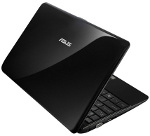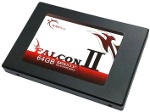I spent last week in San Francisco, attending DrupalCon. Like many geeks, I prefer to have a laptop with me at conferences, so I can take notes, check email and work on stuff if I need or want to.
My laptop is a rather lovely HP 6730b with a lot of RAM that does a whopping 1680 x 1050 as native resolution. Great for graphics and having lots of terminals open - less great for portability. HP also seems to have taken the 12 cell add-on battery for it off the market, so it only gives me about 2½ to 3 hours of run-time (with wi-fi enabled) as well.
 At DrupalCon I developed netbook envy, so upon arriving home I decided I needed something a lot more portable and with far better battery life.
At DrupalCon I developed netbook envy, so upon arriving home I decided I needed something a lot more portable and with far better battery life.
I did a bit of research and found that all manufacturers offer virtually identically spec'd netbooks that contain an Atom N450, 1GB RAM, 250GB HDD and a 10.1" screen. The only point of difference seems to be the battery size, which ranges from 3 cell to 6 cell Li-ion.
A friend told me he'd just bought an Eeepc 1005P for just over $400, which is actually much cheaper than the competition. Sadly that was with a 10% discount campaign, which is no longer running. Still, the 1005P was at least $30 cheaper than the closest competitor and it does come with a 6 cell battery.
So I picked one up at JB Hi-Fi yesterday.
I'd noticed on my wife's netbook that the main performance bottleneck seems to be the harddisk, so I'd also set my mind on replacing the HDD with an SDD. Apart from speeding things up, that should hopefully also help eke some more run-time out of a single charge.
 A quick search for reviews and limited availability of alternatives (need instant gratification now!) made me choose a 64GB G.Skill Falcon II. This SSD has far less capacity than the bundled 250GB sata drive, but then again this is supposed to be a netbook and I do still have the HP to use as portable workstation.
A quick search for reviews and limited availability of alternatives (need instant gratification now!) made me choose a 64GB G.Skill Falcon II. This SSD has far less capacity than the bundled 250GB sata drive, but then again this is supposed to be a netbook and I do still have the HP to use as portable workstation.
A 15 minute operation involving the destruction of a "warranty void" seal saw the SSD installed and the HDD removed. Since I never actually booted (Windows 7) off the HDD I might be tempted to ask for a Windows refund.
I had read about some possible keyboard and trackpad issues under Linux, so the next step was to create a FreeDOS bootable USB key in order to flash the machine up to the latest BIOS version. That worked flawlessly.
Unfortunately the Debian Squeeze netinst iso doesn't support the wired ethernet adapter (wireless is detected though), so I have not yet been able to install Debian on the Eep. Again under the motto of instant gratification I opted to install Ubuntu 10.04 until I had time to sort out Debian.
To make installation less painful than first booting into a full GUI and because I hate the UNR interface with a passion, I went for the "alternate" installer. I made a bootable USB key using usb-creator, which also worked flawlessly.
Because I was installing onto SSD I followed Ted Tso's fdisk and mkfs instructions by way of the Debian EeeC HowTo. I went for 16GB /, 4GB swap and 44GB /home partitions. For both data partitions I chose ext4 with the noatime and data=ordered mount options. Those should mininise wear on the SSD and still give decent speed.
The swap partition is only there to allow the machine to hibernate, so I added vm.swappiness=1 in my /etc/sysctl.conf file.
During installation the wired network adapter was again not detected, but after the first boot it shows up just fine. I didn't experience any oddness during installation and after bootup the keyboard, trackpad, wireless and bluetooth all work. There was (documented) random behaviour with the F5 and F6 backlight hot keys, but the solution for that is also documented:
Append acpi_osi=Linux acpi_backlight=vendor to the GRUB_CMDLINE_LINUX_DEFAULT line in /etc/default/grub and then run the update-grub2 command and reboot. That makes the backlight respond normally to the hot keys. You can check that the options took via cat /proc/cmdline.
So I now have a fully working netbook which boots from POST to login screen in under 4 seconds and has been going for about 8 hours on its charge now.
Whee! :-)
| Attachment | Size |
|---|---|
| 42.59 KB | |
| 1.44 KB | |
| 19.24 KB | |
| 29.56 KB |

Comments
You make it sound so easy!
You make it sound so easy! Sounds good though.
Are there no netbooks that sell with SSDs to save the tinkering? or is DIY just cheaper?
Re: so easy
I honestly hadn't looked for netbooks that come with SSDs. The original Eeepcs did - they had 4GB SSD storage. However, I've not seen SSD mentioned on cheap netbooks for ages, only on premium laptops like a Macbook Air or as an extra-cost option on other laptops.
So I guess even if they're available, DIY is in all likelihood way cheaper - plus you get to pick the model you want :-)
battery life comparisons
Number of cells is a poor measure of battery life: you know that different AAA batteries (cells, to use the technical name) have different capacities, and indeed some 3-cell laptop batteries have greater capacity than some 6-cell laptop batteries.
(I forget the details of where I saw such a case, but I think the 3-cell battery in question was in a EEE, possibly one of the original 7" ones, while the 6-cell battery was in a cheap non-netbook laptop. I think my claim of greater "capacity" was based on a comparison of the quoted Amp-hours, and that no watt-hour numbers were available.)
Thus, if available, I suggest comparing Amp-hours or watt-hours rather than number of cells; and I'd suggest writing accordingly, so as not to encourage others to compare based on number of cells other than as last resort. (If there were some standard benchmark of laptop battery life or power use as a whole, then that would be better still, at least if comparing more differing hardware.)
Add new comment